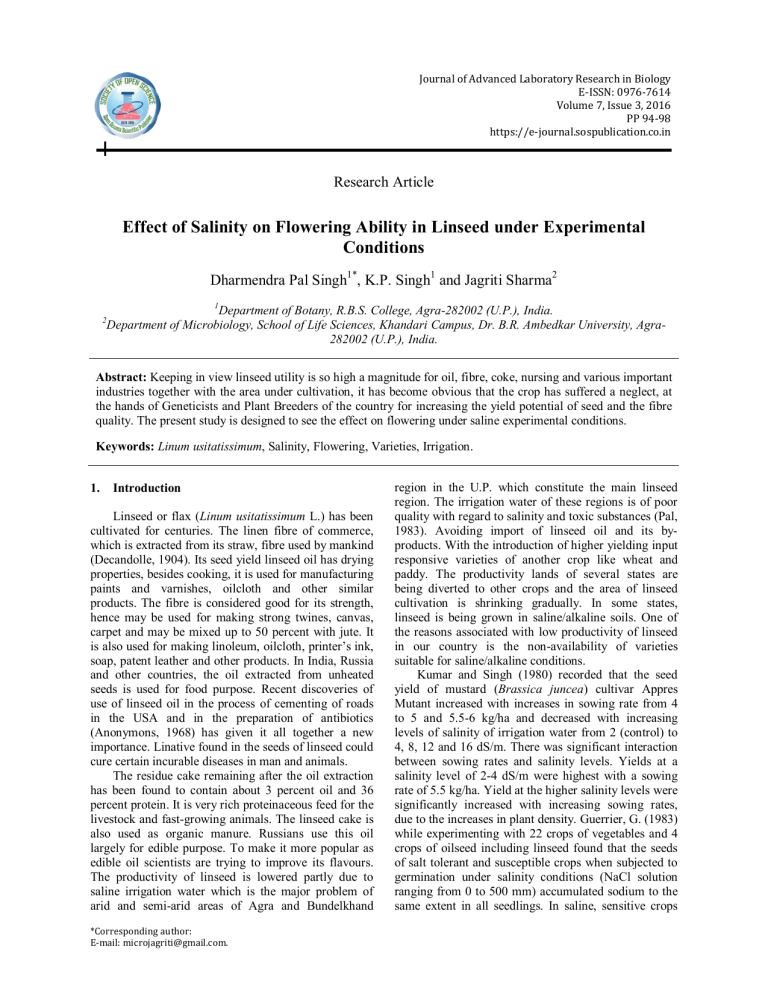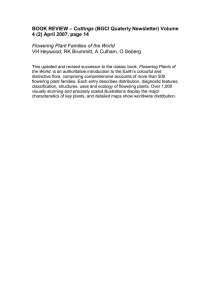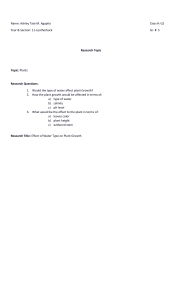Effect of Salinity on Flowering Ability in Linseed under Experimental Conditions
advertisement

Journal of Advanced Laboratory Research in Biology E-ISSN: 0976-7614 Volume 7, Issue 3, 2016 PP 94-98 https://e-journal.sospublication.co.in Research Article Effect of Salinity on Flowering Ability in Linseed under Experimental Conditions Dharmendra Pal Singh1*, K.P. Singh1 and Jagriti Sharma2 1 2 Department of Botany, R.B.S. College, Agra-282002 (U.P.), India. Department of Microbiology, School of Life Sciences, Khandari Campus, Dr. B.R. Ambedkar University, Agra282002 (U.P.), India. Abstract: Keeping in view linseed utility is so high a magnitude for oil, fibre, coke, nursing and various important industries together with the area under cultivation, it has become obvious that the crop has suffered a neglect, at the hands of Geneticists and Plant Breeders of the country for increasing the yield potential of seed and the fibre quality. The present study is designed to see the effect on flowering under saline experimental conditions. Keywords: Linum usitatissimum, Salinity, Flowering, Varieties, Irrigation. 1. Introduction Linseed or flax (Linum usitatissimum L.) has been cultivated for centuries. The linen fibre of commerce, which is extracted from its straw, fibre used by mankind (Decandolle, 1904). Its seed yield linseed oil has drying properties, besides cooking, it is used for manufacturing paints and varnishes, oilcloth and other similar products. The fibre is considered good for its strength, hence may be used for making strong twines, canvas, carpet and may be mixed up to 50 percent with jute. It is also used for making linoleum, oilcloth, printer’s ink, soap, patent leather and other products. In India, Russia and other countries, the oil extracted from unheated seeds is used for food purpose. Recent discoveries of use of linseed oil in the process of cementing of roads in the USA and in the preparation of antibiotics (Anonymons, 1968) has given it all together a new importance. Linative found in the seeds of linseed could cure certain incurable diseases in man and animals. The residue cake remaining after the oil extraction has been found to contain about 3 percent oil and 36 percent protein. It is very rich proteinaceous feed for the livestock and fast-growing animals. The linseed cake is also used as organic manure. Russians use this oil largely for edible purpose. To make it more popular as edible oil scientists are trying to improve its flavours. The productivity of linseed is lowered partly due to saline irrigation water which is the major problem of arid and semi-arid areas of Agra and Bundelkhand *Corresponding author: E-mail: microjagriti@gmail.com. region in the U.P. which constitute the main linseed region. The irrigation water of these regions is of poor quality with regard to salinity and toxic substances (Pal, 1983). Avoiding import of linseed oil and its byproducts. With the introduction of higher yielding input responsive varieties of another crop like wheat and paddy. The productivity lands of several states are being diverted to other crops and the area of linseed cultivation is shrinking gradually. In some states, linseed is being grown in saline/alkaline soils. One of the reasons associated with low productivity of linseed in our country is the non-availability of varieties suitable for saline/alkaline conditions. Kumar and Singh (1980) recorded that the seed yield of mustard (Brassica juncea) cultivar Appres Mutant increased with increases in sowing rate from 4 to 5 and 5.5-6 kg/ha and decreased with increasing levels of salinity of irrigation water from 2 (control) to 4, 8, 12 and 16 dS/m. There was significant interaction between sowing rates and salinity levels. Yields at a salinity level of 2-4 dS/m were highest with a sowing rate of 5.5 kg/ha. Yield at the higher salinity levels were significantly increased with increasing sowing rates, due to the increases in plant density. Guerrier, G. (1983) while experimenting with 22 crops of vegetables and 4 crops of oilseed including linseed found that the seeds of salt tolerant and susceptible crops when subjected to germination under salinity conditions (NaCl solution ranging from 0 to 500 mm) accumulated sodium to the same extent in all seedlings. In saline, sensitive crops Effect of Salinity on Flowering Ability in Linseed seeds with very low Ca and/or K reserves were found whereas in most tolerant crops high reserves of Ca and/or K were found. No significant pattern of mineral reserves was observed for species with average salt tolerance like linseed. 2. Materials and Methods The material for this experiment comprises 10 selected varieties of linseed (Linum usitatissimum L.) out of 50 varieties for their relative salinity tolerance. Seeds of 50 varieties of linseed were obtained from the Coordinator, All India Coordinated Research Project (Linseed), Chandrashekhar Azad University of Agriculture and Technology, Kalyanpur, Kanpur. Preliminary screening of these varieties against various levels of salinity was done at R.B.S. College Agriculture Research Farm, Bichpuri, Agra and 10 varieties showing relative tolerance to salinity were selected for the present study during the 2002-2003 crop season. The seeds of 10 selected varieties namely Neelum, DPL-121, T-65, S-36, Hira, K-2, Gaurav, Subhra, Neela and LCM-926 were sown in well laid out plots at R.B.S. College Agriculture Research Farm, Bichpuri, Agra on during 2002-2003 crop season and 2003-04 crop season, in a “Split Plot Design” with three replications. The distances between row to row and plant to plant were kept 30 cm and 7 cm respectively. All possible reciprocal crosses were attempted amongst 10 varieties of linseed at best water and saline water conditions in 2002-03. Seventy-one hybrids thus generated at best water and 66 hybrids under saline water were sown during 2003-04. The data were recorded from each plot on the randomly selected plants to study following characters during both crop seasons. Germination and Plant height was measured 15 days before harvest by taking vertical height starting from soil surface to the tallest shoot. 2.1 Experimental site, Climate and weather conditions The experiment was conducted at R.B.S. College Agriculture Research Farm, Bichpuri, Agra for two consecutive rabi crop seasons. During both crop seasons, the experimental site remained the same. The depth of the groundwater table remained around 14.00 meters from soil surface. The R.B.S. College Agriculture Research Farm is located at 28.3E longitudes and 169.5 m above mean sea level. The climate is semi-arid and sub-tropical with hot dry summers and severely cold winters. In summers, temperature goes up to 460C with desiccating westerly wind and in winters it falls up to 10C with occasional ground frost. The average annual rainfall is about 650 mm of which 80 percent in received during July and August. J. Adv. Lab. Res. Biol. Dharmendra et al Physiochemical characters of the Experimental soil before sowing. S. No. 1. 2. 3. 4. 5. 6. 7. 8. 9. Particulars Texture Saturation (%) Hydraulic conductivity (cm/hr) Available N Available P2O5 Available K2O pH EC (dS/m) Percentage of CaCO3 Sandy Loam 26.25 1.50 79 Kg/ha 18.65 Kg/ha 456 Kg/ha 8.18 1.95 0.51 During both crop seasons, i.e. 2002-03 and 200304 three salt irrigations were applied. First irrigation was given before 8 days of sowing, second after 40 days and third after 80 days of sowing. The water for three irrigations was prepared by dissolving six salts viz. NaCl, Na2SO4, Na2CO3, MgSO4, MgCl2, CaCl2 in the canal water and different levels of EC (8, 10 and 12) were maintained through required quantity of salts. Salinity with 4 levels: S0 = best water; S1 = EC–8; S2 = EC–10; S3 = EC–12. Varieties: P1 = Neelum; P2 = DPL–121; P3 = T–65; P4 = S–36; P5 = Hira; P6 = K–2; P7 = Gaurav; P8 = Subhra; P9 = Neela; P10 = LCM–926. 2.2 Days to 50 percent flowering The number of days taken from the days of sowing to the opening of 50 percent flower, in a row of variety was recorded. 2.3 Statistical analysis The experimental observations recorded on the characters mentioned earlier have been subjected to the following biometrical analysis in hybrid population of two consecutive years and F2 population of one year only in the present investigation. 3. Results and Discussion A perusal of Table 1 shows that the duration for 50 percent flowering under timely sown condition in all varieties increased in the salinity levels S1 and thereafter decreased at S2 and S3. But significant increase was noted only at S1 level. In the late sown crop of 2003-04, fluctuating trends were observed. After a marginal increase of a few hours at S1, there was an increase of about half day at S2 level. Further increase in salinity at S1 increased the duration of 50 percent flowering by 18 hours, thereafter a gradual reduction of one day in the duration of flowering was observed from S2 to S3. Significant increase in flowering duration was observed only at S1 stage in the timely sown crop. 95 Effect of Salinity on Flowering Ability in Linseed Dharmendra et al Table 1. Effect of various salinity levels on days to 50 percent flowering in ten varieties of Linseed at two successive crop seasons. Salinity Levels S0 S1 S2 S3 C.D. at 5% C.D. at 1% Crop Season 2002-03 88.90 89.70* 88.00 88.08 0.93* 1.32** 2003-04 89.03 89.78* 88.14 88.02 2.10* 2.99** Table 2. Average duration for 50 percent flowering of each variety at combined salinity conditions from S1 to S3. Varieties P1 P2 P3 P4 P5 P6 P7 P8 P9 P10 C.D. at 5% C.D. at 1% Crop Season 2002-03 88.90 85.45** 88.07 98.15** 88.00 87.30** 88.35 87.40** 88.70 87.00 1.00* 1.32** 2003-04 89.26 85.09** 88.60 97.40** 88.50 87.00** 88.07** 88.14* 89.07 87.00 0.96* 1.26** Table 3. Effect of three levels of salinity on ten varieties of Linseed for days to 50 percent flowering during 2002-03. Varieties P1 P2 P3 P4 P5 P6 P7 P8 P9 P10 C.D. at 5% C.D. at 1% S0 89.00 85.68** 89.99 96.20** 88.33 88.00 86.33* 86.40* 90.00 87.01 S1 91.00 88.70 87.50** 98.15** 86.70** 87.15** 89.35 91.66 90.00 86.50** S2 87.35 82.33* 85.00 100.33** 87.40 89.40 89.15 89.15 87.50 86.75 S3 87.33 82.00** 85.70 100.66** 87.40 87.40 88.70 88.10 87.10 86.66 2.46* 3.24** Table 4. Effect of three levels of salinity on ten varieties of Linseed for days to 50 percent flowering during 2003-04. Varieties P1 P2 P3 P4 P5 P6 P7 P8 P9 P10 C.D. at 5% C.D. at 1% J. Adv. Lab. Res. Biol. S0 89.40 86.00* 90.18 95.50** 89.18 88.85 86.66* 87.55 89.55 87.55 S1 90.50 88.40 89.00 95.16** 88.17 86.83** 89.00 92.30 91.15 87.50* S2 88.70 81.50** 87.00 100.66** 87.70 86.60 88.60 86.83 87.33 86.70 S3 88.60 81.66** 86.68 100.00** 87.40 86.15 89.00 87.00 87.20 87.00 2.36* 3.10** 96 Effect of Salinity on Flowering Ability in Linseed Dharmendra et al Table 5. Comparative effect of salinity on days to 50 percent flowering in the hybrids of Linseed during 2003-04. Crosses P1 x P2 x P3 x P4 x P5 x P6 x P7 x P8 x P9 x P10 P4 x P1 xP2 x P3 x P5 x P6 x P7 x P8 x P9 x P10 P5 x P1 xP2 x P3 x P4 x P6 x P7 x P8 x P9 x P10 P6 x P1 xP2 x P3 x P4 x P5 x P7 x P8 x P9 x P10 S0 -87.00 -91.00 -87.00 -88.00 -88.00 -87.00 -88.00 -89.00 -87.00 -88.00 -89.00 -87.00 -90.00 -89.00 -88.00 -88.00 -89.00 -89.00 -88.00 -88.00 -87.00 -90.00 +90.00 -88.00 -87.00 -87.00 -86.00 -87.00 +93.00 -85.00 -86.00 -88.00 +90.00 -85.00 -88.00 -86.00 S1 +90.00 -88.00 -90.00 -90.00 -89.00 +91.00 -90.00 -88.00 -88.00 -90.00 -84.00 -90.00 -90.00 -90.00 -95.00 -89.00 -89.00 -87.00 +89.00 -87.00 -89.00 -86.00 -87.00 -86.00 -89.00 -86.00 -88.00 -86.00 +90.00 -88.00 -86.00 -85.00 -88.00 -88.00 -87.00 Table 2 shows that during both crop seasons duration of 50 percent flowering increased significantly in P4 whereas in all other cultivars the reduction in the duration of 50 percent flowering was either statistically significant or insignificant. P2 (DPL–121), P6 (K–2), P8 (Subhra) and P10 (LCM–926) showed significant reduction during both crop seasons. When compared to interaction of various salinity levels to individual linseed variety, it is observed that significant variation for 50 percent flowering for different varieties was not consistent (Table 3 and 4) variety P4 (S-36) showed statistically significant increase during both crop seasons whereas all other varieties showed fluctuating trends. Among the hybrids (Table 5) fifteen combinations in best water and 6 at 8 dS/m salinity showed delayed flowering over their late flowering parents. Cross combination S–36 x Gaurav (P4 x P7) surpassed all the varieties and hybrids for duration to 50 percent flowering. Days required to 50 percent flowering were variable in different cultivars. When J. Adv. Lab. Res. Biol. Crosses P7 x P1 xP2 x P3 x P4 x P5 x P6 x P8 x P9 x P10 P8 x P1 xP2 x P3 x P4 x P5 x P6 x P7 x P9 xP10 P9 x P1 xP2 x P3 x P4 x P6 x P7 x P8 x P9 x P10 P10 x P1 xP2 x P3 x P4 x P5 x P7 x P8 x P9 x P10 S0 +91.00 +86.00 -87.00 -90.00 -88.00 +88.00 +90.00 -88.00 +89.00 -87.00 +87.00 -86.00 -89.00 -84.00 -85.00 +88.00 -85.00 -85.00 +89.00 +89.00 -90.00 -88.00 -92.00 -88.00 -88.00 +90.00 -83.00 +87.00 -87.00 -90.20 -85.00 -86.00 +90.00 -85.00 -86.00 S1 -88.00 -85.00 -87.00 -89.00 -88.00 -89.00 -89.00 -87.00 -89.00 -85.00 -90.00 -88.00 -88.00 -84.00 -90.00 -89.00 -89.00 -88.00 -88.00 -88.00 -90.00 -90.00 -89.00 -88.00 +89.00 -87.00 -90.00 -88.00 -87.00 -85.00 -88.00 compared with Neelum under best water conditions. Varieties DPL–121, Garima and LCM–926 showed early flowering and S–36, T–65 and Neela showed late flowering. Increasing salinity levels increased duration of flowering in S–36 and Garima. As compared with Neelum, a maximum difference of about 13 days was observed in S–36 at 10 and 12 dS/m salinity levels during both crop seasons. On the other hand, Gaurav showed only a marginal increase over Neelum. Variety T–65 showed reduction in the duration of 50 percent flowering with increasing salinity levels. This trend of earliness in flowering was also noted in the remaining varieties. However, it was interesting to note that in Neelum, DPL–121, Subhra and Neela the duration of flowering was increased at 8 dS/m salinity when compared with their best water counterparts. These varieties appear to have interacted for better adaptation at this level of salinity. Further increase in salinity decreased the flowering duration. Thus increase in duration of flowering with increasing salinity may be 97 Effect of Salinity on Flowering Ability in Linseed attributed to stress conditions and delayed flowering in S–36 and Gaurav was exceptional due to their better tolerance for salinity. Among the hybrids 33 combinations in best water and 31 combinations at 8 dS/m salinity showed delayed flowering over their better parent and cross combination S–36 x Gaurav surpassed all other hybrids and varieties for late flowering. The present findings will be helpful in opening new doors to investigate further improvements in linseed production. References [1]. Berti, M.T., Johnson, B.L., Manthey, L.K. (2007). Seed Physiological Maturity in Cuphea. Ind. Crops Prod., 25:190-201. [2]. Copur, O., Gur, M.A., Karakus, M., Demirel, U. (2006). Determination of correlation and path analysis among yield components and seed yield in oil flax varieties (Linum usitatissimum L.). J. Biol. Sci., 6:738-743. [3]. Ganorkar, P.M. and Jain, R.K. (2013). Flaxseed – A nutritional punch. International Food Research Journal, 20: 519–525. [4]. Heller, K., Wielgusz, K. (2011). Yields of linseed cultivar Bukoz in organic and conventional farming. Journal of Research and Applications in Agricultural Engineering, 56(3): 138–142. J. Adv. Lab. Res. Biol. Dharmendra et al [5]. Kaleem, S. and Hassan, F.U. (2010). Seed and oil distribution in different circles of mature sunflower head. Pak. J. Bot., 42(5): 3005-3014. [6]. Klimek-Kopyra, A., Zając, T., Micek, P.and Borowiec, F. (2013). Effect of mineral fertilization and sowing rate on chemical composition of two linseed cultivars. Journal of Agricultural Science, 5: 224–229. [7]. Meena, R.L, Singh, T.K., Kumar, R., Singh, A.K., Om, H. (2011). Production performance of linseed (Linum usitatissimum L.) to fertility levels and seed rates in dryland conditions of Eastern Uttar Pradesh. Indian Journal of Soil Conservation, 39 (3): 230-235. [8]. Zając T. (2005). Assimilation area and yielding of linseed cultivars depending on sowing density and mineral treatment. Acta Agraria et Silvestria series Silvestris, 45: 65-76. [9]. Zając, T., Oleksy, A., Klimek-Kopyra, A., Kulig, B. (2012). Biological determinants of plant and crop productivity of flax (Linum usitatissimum L.). Acta Agrobotanica, 65: 3-14. [10]. Zhang, H.X., Hodson, J.N., Williams, J.P., Blumwald, E. (2001). Engineering salt-tolerant Brassica plants: characterization of yield and seed oil quality in transgenic plants with increased vacuolar sodium accumulation. Proceedings of the National Academy of Sciences USA. 98: 12832– 12836. 98



